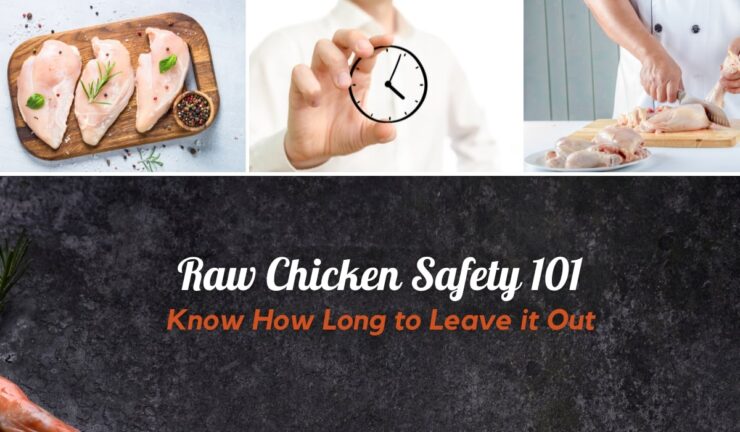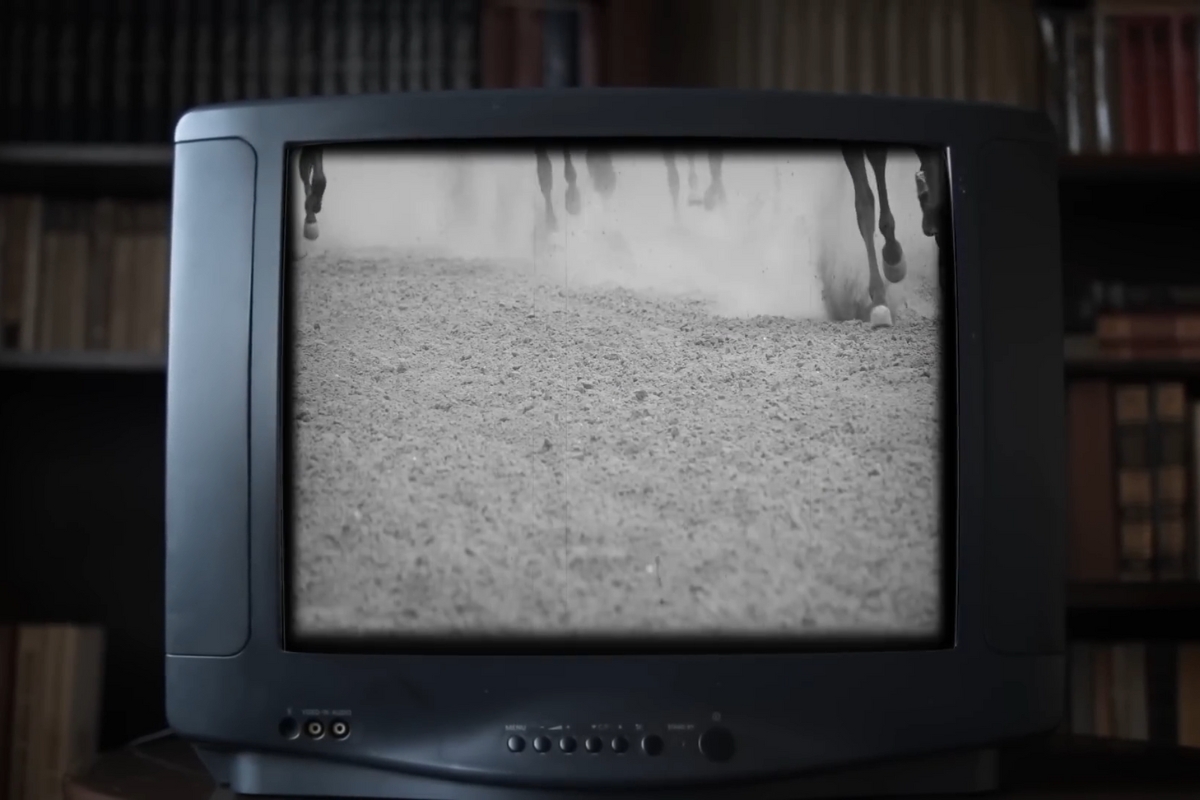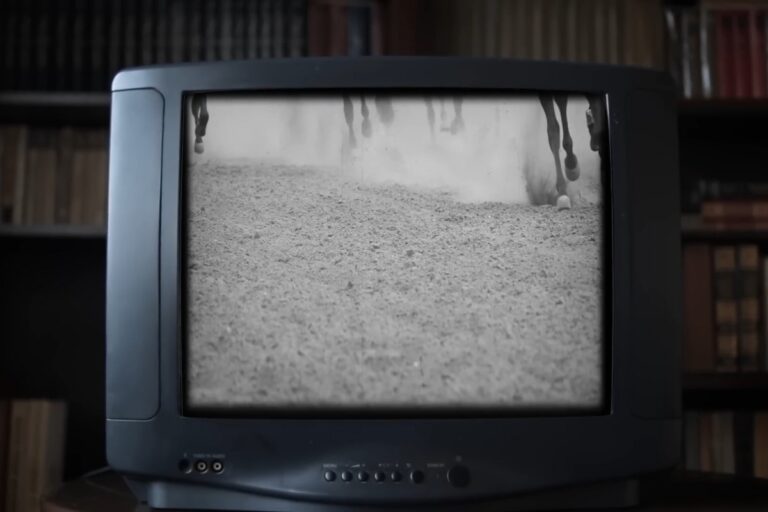As a professional chef, food safety is a top priority in the kitchen. One common question that arises is how long raw chicken can sit out before it becomes unsafe to consume. Understanding the dangers of consuming undercooked chicken is important, as it can cause foodborne illnesses such as salmonella and campylobacter.
Storing Temperature
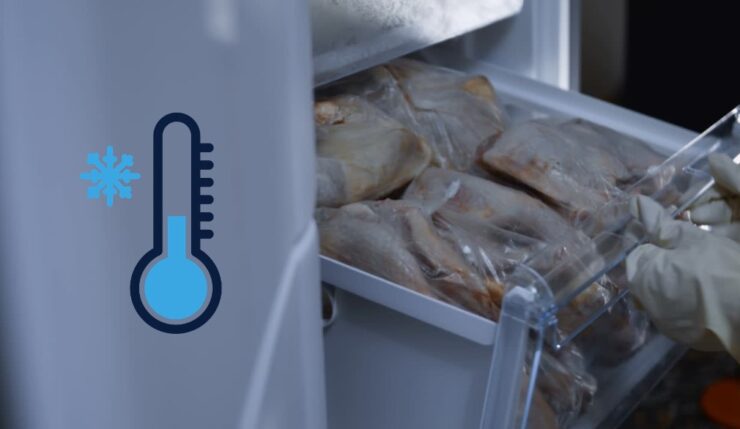
The ideal temperature for storing raw chicken is 40°F or below. When chicken is left out at room temperature, the temperature quickly rises above the safe zone, creating an environment where bacteria can thrive. This can cause the chicken to spoil, leading to potential food poisoning if consumed.
In addition to the time factor, other factors also contribute to the safety of raw chicken. For example, the temperature of the room, the humidity, and the airflow can all affect the rate at which bacteria grows on raw chicken. This is why it’s important to store raw chicken in a refrigerator at a temperature of 40°F or below, or in a cooler with ice packs.
Preparation
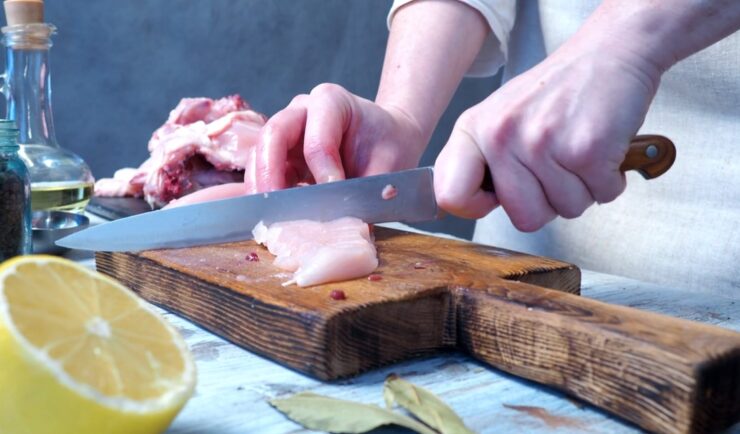
When preparing raw chicken, it’s important to practice good hygiene by washing your hands thoroughly with soap and water before and after handling the meat. The work surface, cutting boards, and utensils should also be thoroughly cleaned to prevent cross-contamination with other food items.
When cooking raw chicken, it’s important to ensure that the internal temperature reaches 165°F, as this temperature is high enough to kill any harmful bacteria that may be present. It’s also important to avoid cross-contaminating cooked chicken with raw chicken, as this can spread bacteria from the raw chicken to the cooked chicken.
In conclusion, as a professional chef, it’s important to understand the dangers of consuming undercooked chicken and to follow food safety guidelines to prevent foodborne illnesses. Raw chicken should never be left out at room temperature for more than two hours, and it’s important to store it in a refrigerator at a temperature of 40°F or below.
Can raw chicken sit out for 3 hours?

No, raw chicken should not sit out at room temperature for more than 2 hours. According to the USDA Food Safety and Inspection Service, raw chicken should be stored in the refrigerator at a temperature of 40°F or below, and should not be left out at room temperature for more than 2 hours.
When chicken is left out at room temperature for more than 2 hours, the temperature quickly rises above the safe zone, creating an environment where bacteria can thrive and multiply. This can cause the chicken to spoil and increase the risk of foodborne illness if it is consumed.
It is important to follow food safety guidelines to prevent foodborne illness and to keep your food safe for consumption. If you are unsure about the safety of raw chicken that has been left out, it is best to discard it to prevent the risk of illness.
Is OK if left out overnight?
No, it is not safe to leave raw chicken out overnight. Raw chicken should always be stored in the refrigerator or freezer to prevent bacterial growth and foodborne illness. Bacteria such as Salmonella and Campylobacter can multiply rapidly at room temperature and make you sick if consumed.
If raw chicken has been left out at room temperature for more than two hours, it is not safe to eat and should be discarded. It’s always best to err on the side of caution when it comes to food safety, especially with raw chicken, as the consequences of food poisoning can be severe.
What happens if you leave the chicken out for 24 hours?
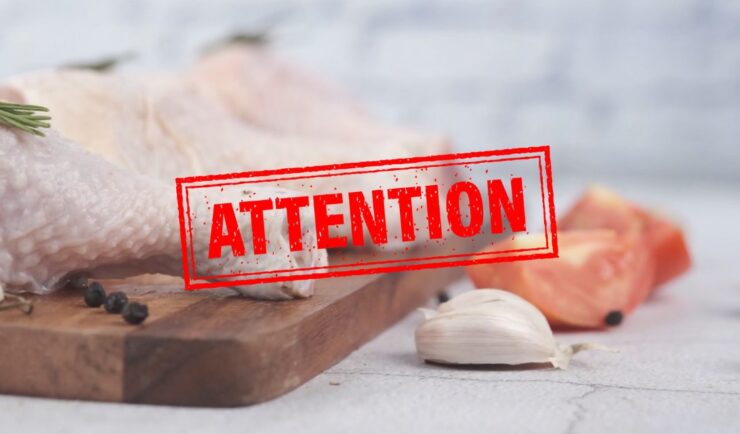
If raw chicken has been left out at room temperature for 24 hours, it is no longer safe to eat and should be discarded.
Bacterial growth on raw chicken can happen quickly, especially in warm conditions, and it’s not possible to determine just by looking at it or smelling it whether the chicken has become contaminated and is no longer safe to eat.
To avoid the risk of food poisoning, it’s important to follow proper food safety procedures, such as refrigerating or freezing raw chicken as soon as possible, and ensuring that it’s cooked to a safe internal temperature of 165°F to kill any harmful bacteria that may be present.
Summary
If raw chicken has been left out at room temperature for 24 hours or more, it is not safe to consume and should be discarded to prevent the risk of foodborne illness.
How long can cooked chicken sit out?
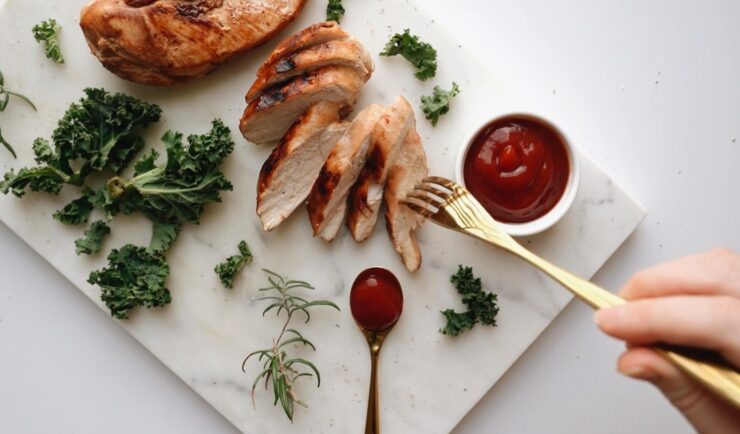
Cooked chicken can sit out at room temperature for up to 2 hours, but it is best to consume it within the first hour to reduce the risk of foodborne illness. Cooked food should not be left at room temperature for more than 2 hours because bacteria can grow rapidly at temperatures between 40°F and 140°F.
After 2 hours, it is best to refrigerate the cooked chicken to slow down the growth of bacteria and extend its shelf life. When stored in the refrigerator, cooked chicken should be placed in an airtight container and consumed within 3 to 4 days.
It is also important to practice good food handling and preparation techniques to reduce the risk of foodborne illness. This includes washing your hands before handling food, avoiding cross-contamination between raw and cooked foods, and following safe cooking temperatures to kill any harmful bacteria that may be present.
Summary
Cooked chicken can sit out at room temperature for up to 2 hours, but it is best to consume it within the first hour to reduce the risk of foodborne illness. To extend its shelf life, it should be refrigerated and consumed within 3 to 4 days. (Note that there is a fee for Pet Poison Helpline).
In addition to following safe food handling practices, you can also add some flavor to your meals by incorporating herbs like African Blue Basil.
Can you refreeze thawed chicken?
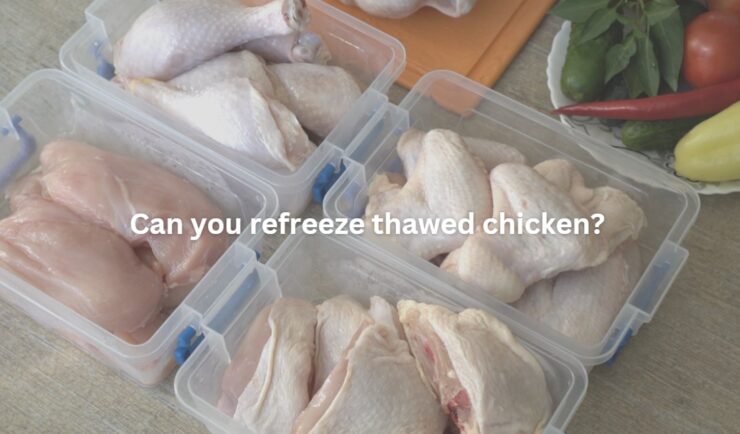
Yes, you can refreeze thawed chicken under certain conditions. It is safe to refreeze thawed chicken if it was thawed in the refrigerator and has not been left at room temperature for more than 2 hours.
When refreezing chicken, it is important to ensure that it has been stored at a temperature of 40°F or below throughout the thawing process.
To refreeze thawed chicken, place it in an airtight container or freezer bag, removing as much air as possible to reduce freezer burn. Label the package with the date it was thawed and place it in the freezer.
It is also important to keep in mind that refreezing chicken may affect the quality and texture of the meat. The repeated freezing and thawing process can cause ice crystals to form within the chicken, leading to a drier and less tender product.
Summary
You can refreeze thawed chicken if it has been stored in the refrigerator and has not been left at room temperature for more than 2 hours. However, it is important to ensure that it is stored at a temperature of 40°F or below and to label the package with the date it was thawed to keep track of its freshness.
How long can you leave the frozen chicken in the freezer?
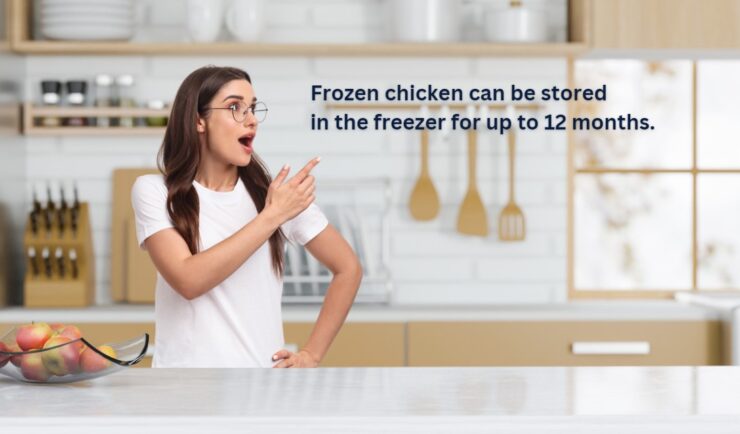
Frozen chicken can be stored in the freezer for up to 12 months, but it is best to consume it within 6 to 9 months for optimal quality and freshness. The length of time that frozen chicken can be stored in the freezer depends on the temperature of the freezer and the conditions in which it is stored.
To ensure that frozen chicken stays fresh for as long as possible, it is important to store it in a freezer with a temperature of 0°F or below. This helps to prevent bacteria growth and freezer burn, which can affect the quality and taste of the chicken.
When storing frozen chicken, it is also important to protect it from freezer burn by wrapping it tightly in an airtight container or freezer bag, removing as much air as possible. Labeling the package with the date it was frozen can also help to keep track of its freshness and prevent it from being stored in the freezer for too long.
It is also important to avoid overcrowding the freezer, as this can affect the temperature and circulation of air, leading to uneven freezing and an increased risk of freezer burn.
What are the signs of spoiled chicken?
Appearance:
- Changes in color: Raw chicken should have a pinkish hue, while cooked chicken should be white or light yellow. If the chicken has changed to a gray or greenish color, it is likely spoiled.
- Sliminess: If the chicken feels slimy or slippery to the touch, it is a sign that it is no longer safe to eat.
Smell:
- Unpleasant odor: If the chicken has a strong, pungent odor, it is a sign that it has gone bad.
- Lack of odor: If the chicken has no noticeable odor, it may still be safe to eat, but it’s a good idea to check its appearance and feel for other signs of spoilage.
Taste:
- Sour or rancid taste: If the chicken tastes sour or rancid, it is likely spoiled and should not be consumed.
Most popular CHICKEN RECIPES

As a professional chef, I have seen that these are some of the most popular chicken recipes that are enjoyed by people all around the world:
- Roasted Chicken: This classic recipe is a simple and flavorful dish that is made by seasoning a whole chicken with herbs and spices, and roasting it in the oven until it is juicy and tender.
- Chicken Parmesan: Chicken Parmesan is a delicious Italian-American dish that is made by breading and frying chicken cutlets, then topping them with marinara sauce and melted mozzarella cheese.
- Grilled Chicken: Grilled chicken is a summer favorite that is made by marinating chicken in a flavorful blend of spices, herbs, and liquids, and then grilling it until it is cooked through and juicy.
- Chicken Fajitas: Chicken fajitas are a Tex-Mex classic that is made by marinating chicken in a spicy mixture, cooking it on a hot skillet, and serving it with sizzling peppers and onions on a warm tortilla.
- Chicken Alfredo: Chicken Alfredo is a creamy and decadent pasta dish that is made by tossing cooked fettuccine with a rich and creamy Alfredo sauce, and topping it with sautéed chicken.
- Chicken Tikka Masala: Chicken Tikka Masala is an Indian dish that is made by marinating chicken in spices and yogurt, and then cooking it in a rich and creamy tomato-based sauce.
- BBQ Chicken: BBQ chicken is a classic American dish that is made by marinating chicken in a sweet and tangy BBQ sauce, and then grilling or baking it until it is caramelized and juicy.
These are some of the most popular chicken recipes that are enjoyed by people around the world. Each of these dishes offers a unique flavor profile and cooking method, making them perfect for a variety of occasions and meal times.
FAQ
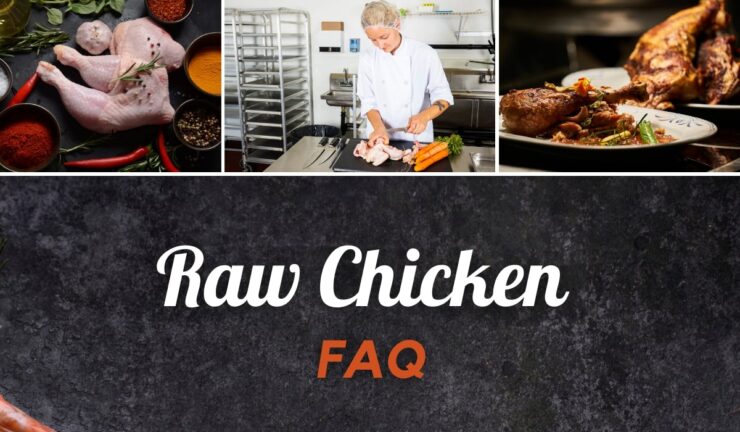
Should you rinse raw chicken before cooking it?
It is not recommended to rinse raw chicken before cooking it. Rinsing raw chicken can actually increase the risk of foodborne illness by spreading bacteria around your kitchen.
When raw chicken is rinsed, water droplets containing bacteria from the chicken’s surface can splash onto kitchen surfaces, including countertops, cutting boards, and utensils. These surfaces can then become contaminated and pose a risk of cross-contamination to other foods, leading to food poisoning.
Additionally, rinsing raw chicken does not necessarily remove all bacteria, and it can be difficult to fully sanitize your kitchen after rinsing chicken. This is because bacteria such as Salmonella and Campylobacter can cling to the chicken’s surface and may not be fully removed by rinsing.
To ensure the safety of your food and prevent foodborne illness, it’s best to simply pat the chicken dry with paper towels before cooking. This helps to remove any surface moisture that could allow bacteria to grow. Additionally, be sure to properly wash your hands, utensils, and kitchen surfaces after handling raw chicken to reduce the risk of cross-contamination.
Can raw chicken sit in the car for an hour?
No, it is not safe to leave raw chicken in a car for an hour, or any length of time for that matter. Raw chicken should always be stored at proper temperatures to prevent bacterial growth and foodborne illness.
A car is not a suitable environment for storing raw chicken, as the temperature inside a car can quickly rise to a dangerous level, particularly in warm or particularly in warm or hot weather.
If you need to transport raw chicken, it’s best to use a cooler with ice packs or to make sure the car’s air conditioning is running to maintain a safe temperature.
How fast can you get food poisoning from raw chicken?

The onset of food poisoning symptoms from consuming raw or undercooked chicken can vary, depending on the specific bacteria involved. In general, symptoms can appear anywhere from a few hours to several days after consuming contaminated chicken.
The most common bacteria found on raw chicken that can cause food poisoning are Salmonella and Campylobacter. Symptoms of salmonellosis, which is caused by Salmonella, can include diarrhea, abdominal cramps, fever, headache, nausea, and vomiting. Symptoms can start anywhere from 6 to 48 hours after exposure and can last for 4 to 7 days.
Campylobacter infection, which is caused by Campylobacter bacteria, can cause similar symptoms, including abdominal pain, diarrhea (often bloody), fever, and vomiting. Symptoms typically appear 2 to 5 days after exposure and can last for up to 10 days.
What should I do if I accidentally eat raw chicken?
If you have accidentally consumed raw chicken, it’s important to take the following steps:
- Monitor your symptoms: If you start to experience symptoms such as nausea, vomiting, diarrhea, abdominal cramps, fever, or headache, it’s important to seek medical attention as soon as possible. These symptoms can be signs of food poisoning, which can be serious and even life-threatening in some cases.
- Stay hydrated: Diarrhea and vomiting can lead to dehydration, so it’s important to drink plenty of fluids, such as water, clear broths, frozen water or ice pops, or sports drinks (such as Gatorade).
- Avoid certain foods: Until you feel better, avoid high-fat foods, dairy products, caffeine, and alcohol, as these can make your symptoms worse.
- Wash your hands: Regularly washing your hands with soap and warm water can help reduce the risk of spreading bacteria to others or to other surfaces in your home.
It’s also a good idea to inform your doctor or healthcare provider that you have consumed raw chicken, as they may need to take special precautions to prevent the spread of bacteria during any medical treatment.
In some cases, the symptoms of food poisoning from raw chicken can be mild and resolve on their own within a few days. However, it’s always best to err on the side of caution and seek medical attention if you experience any concerning symptoms.
Can you cook bacteria out of chicken?
Yes, cooking chicken to a safe internal temperature can kill bacteria and reduce the risk of foodborne illness. Bacteria such as Salmonella and Campylobacter, which are commonly found on raw chicken, can cause food poisoning.
To kill bacteria and ensure that chicken is safe to eat, it’s important to cook it to an internal temperature of 165°F, as measured by a food thermometer. This temperature is high enough to kill harmful bacteria, while still providing a safe and delicious meal.
Does marinating the chicken improve its shelf life?
Marinating does not significantly improve the shelf life of a raw chicken. Marinating is designed to add flavor to the meat, not to extend its shelf life. The marinade can actually increase the risk of bacterial growth if it contains ingredients such as acidic or sugary liquids, which can create an ideal environment for bacteria to thrive.
Final Words
Leaving raw chicken out at room temperature for too long can allow harmful bacteria to grow to dangerous levels, making it unsafe to eat. By following safe food handling practices, such as storing raw chicken in the refrigerator and cooking it to a safe internal temperature, you can ensure that your chicken is safe and enjoyable to eat.
Taking these precautions will not only ensure the safety of the food you consume, but also help prevent the spread of bacteria and protect your health.

